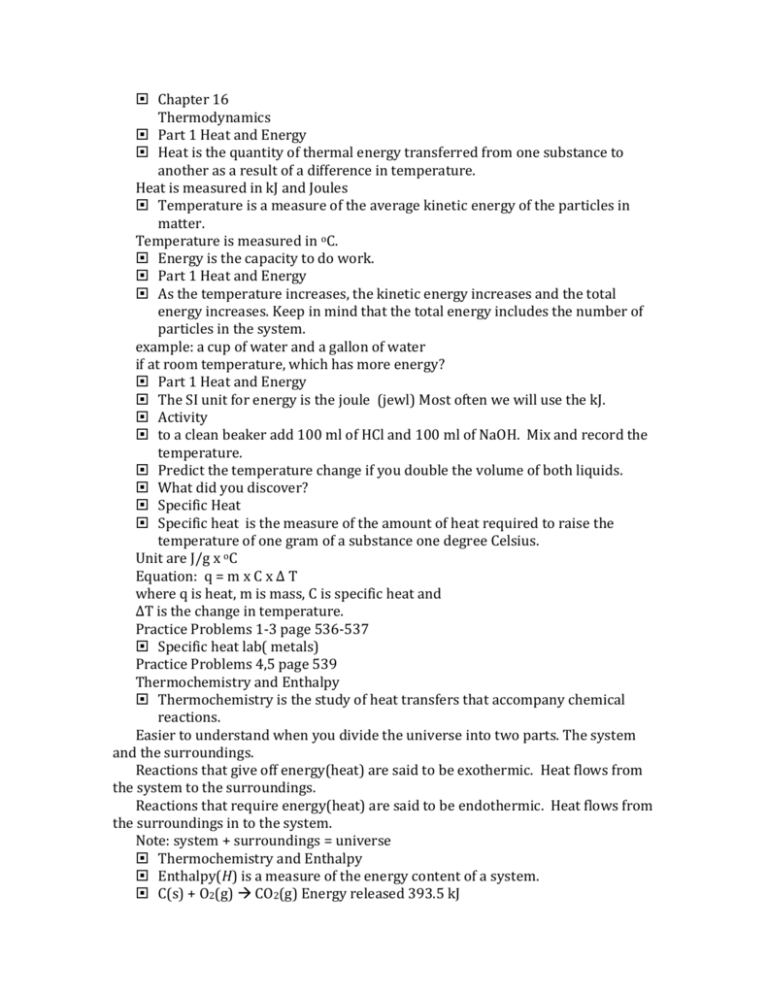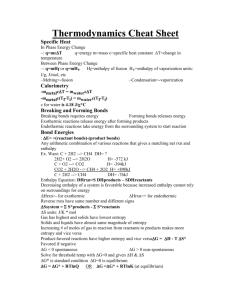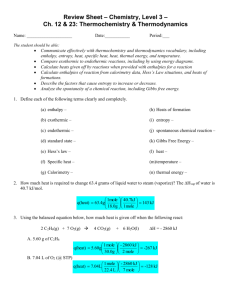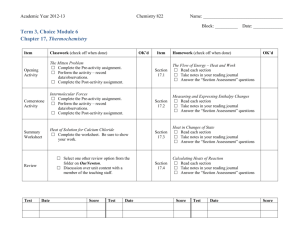Chapter 16 Thermodynamics Part 1 Heat and Energy Heat is the
advertisement

Chapter 16 Thermodynamics Part 1 Heat and Energy Heat is the quantity of thermal energy transferred from one substance to another as a result of a difference in temperature. Heat is measured in kJ and Joules Temperature is a measure of the average kinetic energy of the particles in matter. Temperature is measured in oC. Energy is the capacity to do work. Part 1 Heat and Energy As the temperature increases, the kinetic energy increases and the total energy increases. Keep in mind that the total energy includes the number of particles in the system. example: a cup of water and a gallon of water if at room temperature, which has more energy? Part 1 Heat and Energy The SI unit for energy is the joule (jewl) Most often we will use the kJ. Activity to a clean beaker add 100 ml of HCl and 100 ml of NaOH. Mix and record the temperature. Predict the temperature change if you double the volume of both liquids. What did you discover? Specific Heat Specific heat is the measure of the amount of heat required to raise the temperature of one gram of a substance one degree Celsius. Unit are J/g x oC Equation: q = m x C x Δ T where q is heat, m is mass, C is specific heat and ΔT is the change in temperature. Practice Problems 1-3 page 536-537 Specific heat lab( metals) Practice Problems 4,5 page 539 Thermochemistry and Enthalpy Thermochemistry is the study of heat transfers that accompany chemical reactions. Easier to understand when you divide the universe into two parts. The system and the surroundings. Reactions that give off energy(heat) are said to be exothermic. Heat flows from the system to the surroundings. Reactions that require energy(heat) are said to be endothermic. Heat flows from the surroundings in to the system. Note: system + surroundings = universe Thermochemistry and Enthalpy Enthalpy(H) is a measure of the energy content of a system. C(s) + O2(g) CO2(g) Energy released 393.5 kJ C(s) + O2(g) CO2(g) ΔH = -393.5 kJ Ba(OH)2 + 2NH4Cl BaCl2 +2NH4OH ΔH = +130kJ Demo Enthalpy Standard Enthalpy of Formation is not an exact science. Rather it is like the oC scale. “standard state” is at 25oC and one atm. Any change in either is a change in enthalpy. So, what does this look like? ΔHfo where o is for standard stateand f is for formation of a mole See table 16-4 for standard enthalpies Enthalpy Determining Enthalpy Changes in Reactions Hess’s Law: When reactants are converted to products whether in one step or more, the enthalpy change is the same. Like this: methane to water CH4 +2 O2 CO2 +2H2O C + 2H2 = CH4 -74.8 C + O2 CO2 -393.5 H2 + ½ O2 H2O -285.8 Like this: methane to water CH4 +2 O2 CO2 +2H2O C + 2H2 = CH4 -74.8 C + O2 CO2 -393.5 H2 + ½ O2 2H2O -285.8 Our equation is ΔH = Hproducts - Hreactants -393.5 + 2( -285.8) – (-74.8) = -890.3 Better practice these. Pg 551 # 12 a, b, 17 page 553 Part 3 Spontaneous Process Spontaneous reactions can occur, under specific conditions, without any assistance. Burning Bunsen burner, melting of ice, food coloring in a glass all occur spontaneously. Entropy and Spontaneity Entropy, S, is a measure of disorder. Nature likes disorder. Order requires too much energy. Perfume in a room demonstrates entropy. It spread out, diffuses, on its own(spontaneously.) Part 3 Spontaneous Process Factors that determine spontaneity ΔH (-) Exothermic tend to be spontaneous. ΔS (+) Increased disorder tend to be spontaneous ΔH (+) Endothermic tend to be nonspontaneous. ΔS (-) Increased order tend to be nonspontaneous. Confused??? Spontaneous? ΔS is positive(increased disorder) when… A solid changes into a liquid. A liquid changes into a gas. A solute dissolves in a solvent. A system is heated. A reaction increases the number of particles in the system. 2H2O 2H2O + O2 Gibbs free energy Gibbs free energy, G, is a quantity that takes into account the contributions of enthalpy and entropy when predicting if a reaction will take place. ΔG = Gfinal – Ginitial or ΔG = Gproducts– Greactants Bringing it all together. ΔG = ΔH – TΔS a negative ΔG = spontaneous reaction Gibbs free energy To freeze one mole of water at -10oC you must remove 224J of energy or 224J. ΔG is negative as is ΔH so this occurs spontaneously. At temperatures greater than 0oC TΔS is greater than ΔH so ΔG is positive. We know water won’t freeze spontaneously above 0oC so ΔG must be ___ Gibbs free energy Exothermic reactions and reactions that increase entropy of a system tend to be spontaneous. SO…, -ΔH, +ΔS and, -ΔG Table 16-6 is your friend. Practice #’s 20-22






